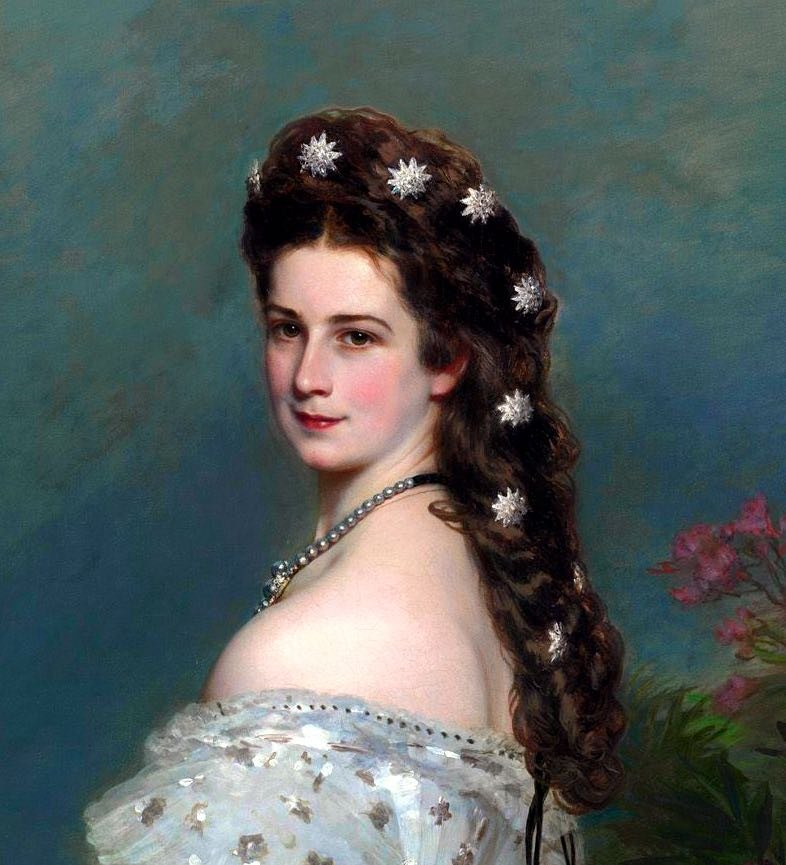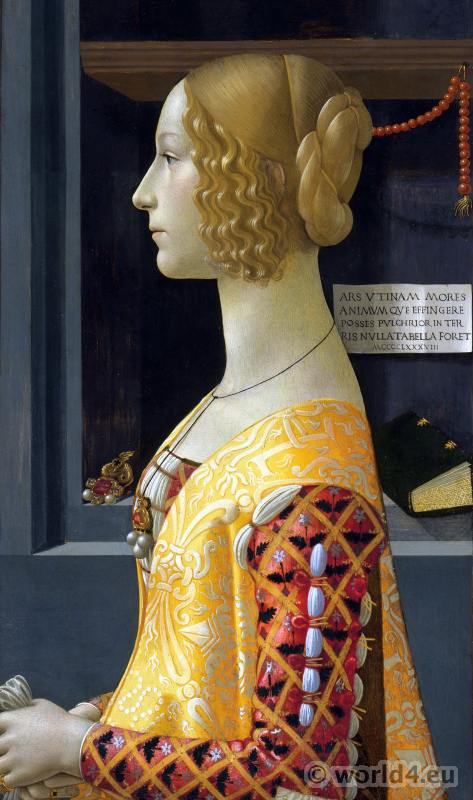Support and Seduction: The History of Corsets and Bras (Abradale Books) by Beatrice Fontanel.
Thoughout the ages, women’s breasts have been subjected to the endless whims of fashion.
From the ancient Greeks to Mae West and Madonna, this light-hearted book charts the changing shapes of female beauty. The elegant and amusing images – including fashion drawings, paintings, photographs, and film stills – illustrate the often surprising history of the garments women have worn for support – and seduction.

CHAPTER IX. Fashion and dress of 1865.
The elegance of dress mainly dependent on the Corset – Fashion and dress of 1865 – The short-waisted dresses and trains of 1867 – Tight Corsets needed for short waists – Letter on the figure – Description of a peculiar form of Corset worn by some ladies of fashion in France – Proportions of the figure and size of the waist considered – The point at which the waist should be formed – Remarks of the older writers on stays – Corsets and high-heeled shoes denounced – Alarming diseases said to be produced by wearing high-heeled shoes – Mortality amongst the female sex not on the increase – Extraordinary statistics of the Corset trade – The Corset of the present day contrasted with that of the olden time.
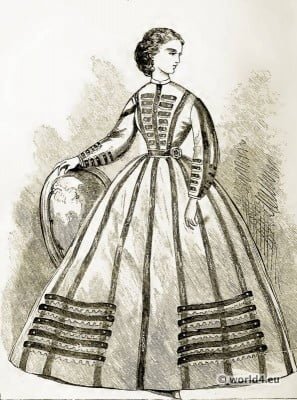
The elegance of dress mainly dependent on the Corset
We could very easily add letters enough to occupy the remaining portion of this work, all incontestably proving that slender waists are, notwithstanding that which some few writers have urged to the contrary, held in high esteem by the great majority of the sterner sex.
Without the aid of the corset, it has been very fairly argued, no dress of the present day could be worn, unless its fair possessor was willing to submit to the withering contempt of merciless society.
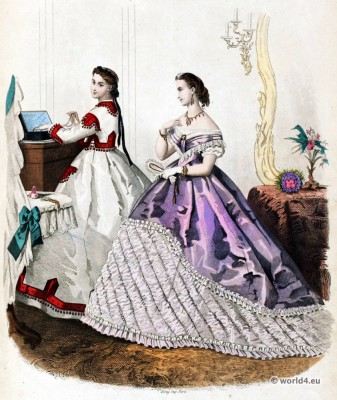
The short-waisted dresses and trains of 1867
The annexed illustration represents a lady dressed in the fashion of the close of 1865, and there are few who would be unwilling to admit its elegance and good taste. One glance at the contour of the figure is sufficient to show the full influence of the modern form of corset on the adjustment of this style of costume, and it would be a waste of both time and space to represent the figure in its uncultivated form similarly arrayed.
In 1867, we find a strong tendency towards the short waists, low dresses, and long trailing trains of old times, and we are forcibly reminded, when contemplating the passing caprice, of the lines from a parody on the “Banks of Banna“:-
“Shepherds, I have lost my waist,
Have you seen my body?”
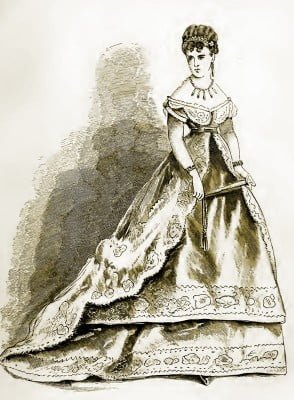
Description of a peculiar form of Corset worn by some ladies of fashion in France
Still the waist is by no means suffered to remain perdu, but, as in 1827, has to be laced with very considerable tightness to compensate the eye for its loss of taperness and length. The annexed illustration represents a lady of fashion of 1867, and it would be a perfect work of supererogation to ask our readers how a lady so dressed would look “unlaced and unconfined.”
The ladies themselves are by far the best judges of the matter, and the following letter from the Englishwoman’s Domestic Magazine will show that the corset has to play an important part in the now-existing style of dress. Thus writes a lady who signs herself Edina:-
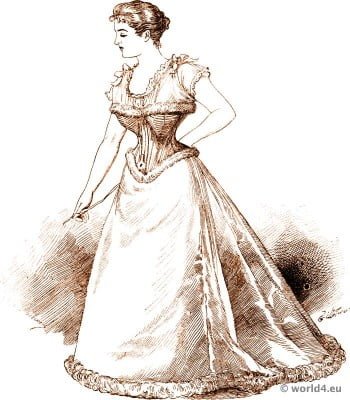
“Allow me to occupy a small portion of your valuable space with the subject of stays. I quite agree with A Young Baronet that all those ladies who possess that most elegant attraction, a slender waist, should not hide it so completely by shawls whenever they promenade. Excuse my offering a few remarks to facilitate that desirable object, a handsome figure.
Corsets and Crinolines 1st Edition by Norah Waugh & Judith Dolan.
In this classic book, Norah Waugh explores the changing shapes of women’s dress from the 1500s to the 1920s. Simple laced bodices became corsets of cane, whalebone and steel, while padding at shoulders and hips gave way to the structures of farthingales, hoops and bustles.
Stays and Corsets: Historical Patterns Translated for the Modern Body by Mandy Barrington.
Using her original pattern-drafting system, author Mandy Barrington will show you how to draft a historical pattern for a modern body shape, while still retaining an accurate historical silhouette.
Ladies, when dressing for the afternoon walk or ride, or the evening display, when putting on their stays at first, should not lace them quite tight; in about a quarter of an hour they might again tighten them, and in the course of half an-hour or so lace them to the requisite tightness. They may fancy in this way there is no sudden compression of the waist, and the figure gets more easily accustomed to tight-lacing.
Occasionally, in France, ladies who are very particular about their figures have their corsets made in three pieces, laced down the sides as well as behind, and cut away over the hips; the holes for the laces are very numerous and close together.
This form of corset offers great facilities for the most perfect adjustment to the figure, as well as power of tight-lacing when required, and perfect ease in, walking or dancing. I may add that, in order to insure a good fit and to keep it properly in its place, the busk in front, and the whalebones behind, are made somewhat longer than the present fashion. Perhaps the lady in your September number, who signs herself An Inveterate Tight-Lacer, might find a trial of a corset made in this form a great boon as well as a comfort in tight-lacing.”

Proportions of the figure and size of the waist considered
Practical hints such as these will not fail to be of interest to the reader. Numerous inquiries, as will be seen on reference to the foregoing correspondence, have been made as to what circumference the waist should be to meet the requirements of elegance.
It must be borne in mind, when dealing with this question, that height and breadth of shoulder have much to do with proportionate slenderness of waist. A lady who is tall and wide-shouldered would appear very neatly shaped with a waist laced to twenty or twenty-one inches, whilst with a slight, narrow form of figure that size would carry the appearance of much clumsiness with it.
Madame La Sante says – “A waist may vary in circumference from seventeen to twenty-three inches, according to the general proportions of the figure, and yet appear in all cases slender and elegant.”

We have abundant evidence before us, however, that seventeen inches is by no means the lowest standard of waist-measure to be met with in the fashionable circles of either London, New York, Paris, or Vienna. Numbers of corsets sixteen inches at the waist, and even less, are made in each of these cities every day. In the large provincial towns, both at home and abroad, corset-makers follow out the rules laid down by fashion.
We are disposed to think, therefore, dealing with the evidence before us, that a lady of medium stature and average breadth of shoulder would be subscribing to the laws of fashionable taste if the circumference of her waist was not more than from seventeen to nineteen inches measuring outside the dress.

Fashion has indulged in some strange freaks regarding the length and position of the waist, as a reference to many of the illustrations will show, but its true position can be laid down so clearly that no doubt need remain on the matter. A line drawn midway between the hip and the lowest rib gives the exact point from which the tapering form of the waist should spring, and by keeping this rule in view it appears the statement made by so many ladies (that provided ample space is allowed for the chest the waist may be laced to an extreme of smallness without injury) has much truth to support it.
The contributors to works of popular instruction even in our own day are very lavish in their denunciations of the practice of wearing corsets, and, following in the track of the ancient writers on the same subject, muster such a deadly and tremendously formidable array of ailments, failings, and diseases as inseparably associated with the wearing of that particular article of attire, that the very persons for whom these terrors are invoked, seeing from their own daily experience how overdrawn they are and how little knowledge their authors show about the subject, laugh the whole matter to scorn and follow the fashion.
Corsets and high-heeled shoes denounced
We have now before us a very talented and well-conducted journal, in which there are some sweeping blows at the use of both corsets and high-heeled boots or shoes, and, as an instance of the frightfully severe way in which the ladies of the time – 1842 – laced themselves, the writer assures us that he had actually seen a young lady’s waist belt which measured exactly “twenty-two inches,” “showing that the chest to which it was applied had been reduced to a diameter (allowing for clothes) of little more than seven inches.”
The chest is thus shown as being about one inch less than the waist. Now, in 1842 it must have been a very eccentric lady indeed who formed her waist round her chest, and as to the twenty-two-inch waistband, we cannot help thinking that the majority of our readers would seek one of considerably smaller size as an indication of the practice of tight-lacing in the owner. And now on the score of high heeled boots and slippers, we are, like the immortal boy in Pickwick, “going to make your flesh creep.” In writing of these terrible engines of destruction our mentor says – “From the uneasiness and constraint experienced in the feet sympathetic affections of a dangerous kind often assail the stomach and chest, as hemorrhage, apoplexy, and consumption. Low-heeled shoes, with sufficient room for the toes, would completely prevent all such consequences.”
How the shareholders of life assurance companies must quake in their shoes as the smart and becoming footgear of the period meets their distracted vision at every turn! and what between the fatal high heels and waists of deadly taperness, it is a wonder that female existence can continue, and that all the policies do not fall due in less than a week, all the undertakers sink into hopeless idiocy in a day from an overwhelming press of business, and all the gentlemen engage in sanguinary encounter for the possession of the “last woman,” who has survived the common fate by reason of her barefooted habits and of her early abandonment of stays.
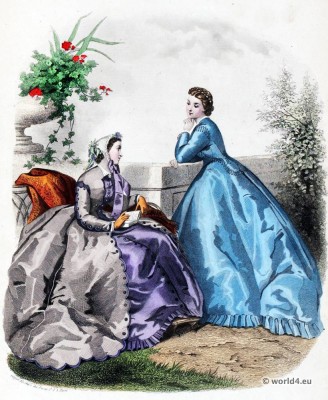
We do not find, as a matter of fact, that the Registrar-General has his duties materially increased, or that the bills of female mortality are by any means alarming, although on a moderate calculation there are considerably over twelve million corsets in the United Kingdom alone, laced with as many laces round as many waists every day in the week, with, in many instances, a little extra tension for Sundays.
Extraordinary statistics of the Corset trade
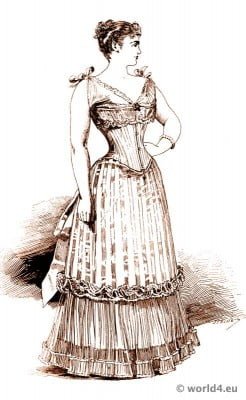
We learn from the columns of Once a Week that the total value of stays made for British consumption annually, cannot be less than £1.000.000 sterling, to produce which about 36.000.000 yards of material are required. The stay trade of London employs more than 10.000 in town and country, whilst the provincial firms employ about 25.000 more; of these, about 8.000 reside in London, and there is about one male to every twenty-five women.
Returns show that we receive every year from France and Germany about 2.000.000 corsets. One corset-manufacturer in the neighbourhood of Stuttgart has, we are informed, over 1300 persons in constant employment, and turns out annually about 300.000 finished corsets.

Messrs. Thomson and Co., the manufacturers of the glove fitting corset, turn out incredible numbers from their immense manufactories in England, America, and on the continent. It will be readily conceived that the colonial demand and consumption is proportionately great.
The quantity of steel annually made use of for the manufacture of stay-busks and crinolines is perfectly enormous. Of the importance of the whale fishery, and the great value of whalebone, it will be needless to speak here, further than to inform our readers that more than half the whalebone which finds its way into the market is consumed by the corset-makers.
Silk, cotton, and wool, in very large quantities, are either spun up into laces or used in the sewing or manufacture of the corset itself. No inconsiderable quantity of timber is made use of for working up into busks.
Oxhorn, ebonite, gutta-percha, and hardened brass are all occasionally used for the same purpose, whilst the brass eyelet-holes, of which we shall have to say more by-and-by, are turned out in such vast and incalculable quantities, that any attempt at computing their number would be useless. It will be seen by these statistics and remarks that, unlike certain other articles of raiment which have reigned in popular esteem for a time, and then passed away, the corset has not only become an established institution throughout the whole civilised world, but is of immense commercial importance, and in rapidly-increasing demand and esteem.
We shall now have to remark on some of the most noteworthy forms of the corset worn at the present day, contrasting them with those of the olden time. The steel corset-covers we have already figured and described. On these contrivances being found heavy and too unbending in their construction, a form of corset was, as we have before said, contrived, which needed no cover to preserve its perfect smoothness of surface and rigidity of form; the front was therefore enriched with gold and silver tissue, and ornamented with embroidery, performing the part of both corset and stomacher, whilst the back was made of a heavier material, because the dress of the period often concealed it.
The annexed illustrations are carefully sketched from a very excellent specimen of this form of corset or bodice, kindly lent us for the purpose by Messrs. Simmons, the well-known costumiers of Tavistock-street, Covent Garden, by whom it has been preserved as a great curiosity. The materials used in its construction are very strong, whilst every part the least liable to be put out of form is literally plated with whalebone, making its weight considerable. The lace-holes are worked with blue silk, and are very numerous and close together.
Source: The Corset and the Crinoline. A Book of Modes and Costumes from remote Periods to the Present Time by W. B. L. (William Berry Lord). With 54 Full-Page and other Engravings. London: Ward, Lock, and Tyler. Warwick House, Paternoster Row. 1868.
Support and Seduction: The History of Corsets and Bras (Abradale Books) by Beatrice Fontanel.
Thoughout the ages, women’s breasts have been subjected to the endless whims of fashion.
From the ancient Greeks to Mae West and Madonna, this light-hearted book charts the changing shapes of female beauty. The elegant and amusing images – including fashion drawings, paintings, photographs, and film stills – illustrate the often surprising history of the garments women have worn for support – and seduction.




